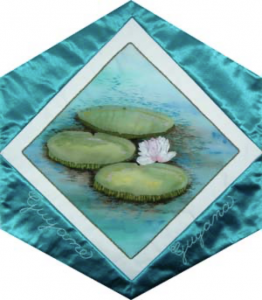Guyana

The Block
As a land known for its many rivers and extensive system of waterways, it is fitting that an aquatic scene be the theme of Guyana’s block. Based on a design chosen by Joan and Paul daSilva, Linda Norton-McLaren hand-painted the country’s national flower onto silk fabric, capturing their shimmering reflection upon the water. She enhanced the painting with stem stitches and surface embroidery. A single, pale pink bloom, which opens on only two successive evenings, is nestled between the plant’s giant, flat, round leaves.
Named for England’s Queen Victoria, the Victoria Regia Lake Lily was called ‘water platter’ by the Indians of British Guiana in reference to its remarkable floating leaves, which at more than 2 metres (6 ft) across can support the weight of a small child. Its starchy seeds, which are hidden in a prickly coconut-sized capsule are known as ‘maize delaqua’ (water corn) in parts of South America where they are used for food.
Cultural Profile
The ‘land of many waters,’ as Guyana is known, aptly describes this South American country. Formerly known as British Guiana before achieving independence in 1966, this tropical republic has three main rivers (the Demerara, Essequibo and Berbice) that lend their names to the nation’s three counties. Much of Guyana is covered by unexplored jungle, which is home to a variety of wild animals, colourful birds and diverse plant life. The country is also home to both the tallest wooden free-standing building in the world, St George’s Cathedral, built in 1892 in the capital city of Georgetown, and one of the world’s natural wonders, Kaieteur Falls. Guyana has the most unusual racial mix in South America and it is woven into all aspects of life. The two largest ethnic groups are East Indian and African, and the official language is English (Guyana is the only country in South America where this is the case), although most Guyanese speak a dialect known as Creolese.
Though located on the South American continent, Guyana is considered to be a Caribbean country, as it has cultural traits such as cooking and music similar to those of the islands. Its native people and ethnic diversity along with the beauty of the land, are dominant influences in the country’s well-developed visual arts, such as painting. Due to the abundance and variety of woods available, sculpture and woodworking are also important art forms. The country is also known for its gold and silver jewellery and cottage crafts, such as basket weaving and beadwork. The Indigenous groups have retained many of their traditions. Traditional weaving and woodcarving are still practised, due in part to the relative isolation of their villages.
In February of each year, Mashramani, the celebration of independence, is an occasion for colourful displays of exuberant costumes, floats, street-dancing and music. Guyanese love to get together with friends and family to share a meal and a good time. They have a great sense of humour and love to illustrate what they say with proverbs drawn from their rich legacy of sayings. The first Guyanese came to Canada during the late nineteenth century, settling in Nova Scotia, Ontario and Québec, but it wasn’t until the 1950s that significant numbers began to arrive as a result of economic instability and growing unemployment at home. Outside central Canada, Guyanese were drawn to large cities in British Columbia and Alberta, providing work opportunities for those in medicine, engineering, insurance, banking, merchants and entrepreneurs. As of 2011, over 75,000 people of Guyanese descent live in Canada. They established sports, dancing and recreational clubs and have contributed to Canadian culture most notably in the area of music, where Canadians have enthusiastically embraced the sound of steel bands, calypso and reggae.
Sponsor: Audrey Bain and Elaine Murdoch, in memoriam Vivian and Samuel Murdoch
